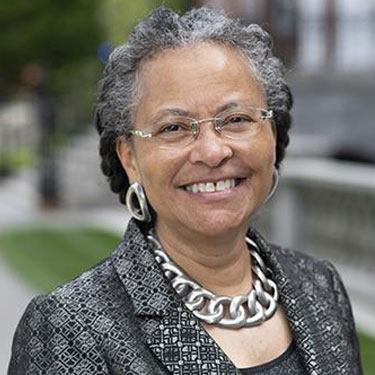Ending Racial Health Disparities Hinges on Penalties, Political Will, Experts Say
MSM's Dr. Camara Jones is among the health equity leaders quoted in a STAT article
about new efforts
to tackle the root causes of health disparities and how to address them.
 Dr. Camara Jones
Dr. Camara Jones
Senior Fellow & Adjunct Professor, Morehouse School of Medicine
By Usha Lee McFarling, STAT
The nation’s widespread racial health disparities won’t be erased without changes to how health care systems are funded and accredited, more public and financial accountability for poor patient outcomes, and more work to overturn the income inequality and residential segregation tied to poorer health and lower life expectancy for many people who are Black and brown.
Those are some of the conclusions of a group of health equity leaders who are gathering this week to build on the work of the landmark National Academies of Sciences, Engineering, and Medicine “Unequal Treatment” report, which was published 20 years ago and was the first major report to point to racism — not lack of insurance, poverty, or refusal to seek care — as a major factor in causing health disparities.
The group is meeting in a series of public workshops over the next few months, sponsored by the National Institutes of Health, to look at the state of the nation’s health disparities and what initiatives may be working to end them. But many at the meeting could not help but express frustration that, as STAT has reported, so little progress has been made since the report was published in 2003.
“It’s 20 years. I sat on the committee,” David R. Williams, a noted health equity scholar who chairs the department of social and behavioral sciences at the Harvard Chan School of Public Health, said Wednesday. “We have not made that much progress. We need to do things differently.”
Another speaker, Tina Cheng, a pediatrician who serves as chief medical officer of Cincinnati Children’s Hospital, said she had reread the report’s 21 detailed recommendations to prepare for the workshop. “It did make me a little sad because a lot of those recommendations were not implemented,” she said. “I hope this committee will dig into why.”
Many of the nation’s health disparities have barely budged, or even worsened, since the report was released: Black women are three times more likely than white women to die in childbirth, and Black babies are nearly three times more likely to die in infancy than white babies. Overall, Black Americans live nearly six years less than white Americans.
STAT’s reporting found that reasons the report did not spark more change included discomfort with discussing the topic of race, denial among health care providers that they might be biased against patients of color, poor tracking of racial and ethnic data for patient outcomes, and a lack of consistent political will to attack the many problems the report had uncovered.
That political will, many speakers noted, is still lacking. “We need a social movement,” said Williams, adding that many people working to end racism within health care are being regularly attacked for being divisive and inventing problems that don’t exist — just as they were 20 years ago.
Other speakers said they worried that the national conversation surrounding health disparities was drifting away from directly confronting issues of racism and discrimination, despite the fact these issues still loom large in medicine. Carl Hill, the chief diversity, equity, and inclusion officer of the Alzheimer’s Association, cited a study his organization undertook in 2021 that found more than half of non-white caregivers reported being discriminated against as they sought care. Hill said he was concerned that the current focus on diversity, equity, and inclusion rather than racism in health care created the “critical risk…we lose a focus on discrimination.”
Twenty years after the report detailed evidence that bias and stereotyping pervade health care, Hill said, society “is back to debating whether generational multilevel impact of racial and ethnic discrimination is real, and that is disheartening.”
Camara Jones, a physician and leading health equity researcher from the Morehouse School of Medicine, stressed to the panel that the first step in confronting racism is naming it. “Say the whole word. Ask how is racism operating here?” she said. “We need more conversations around our boardroom tables, faculty tables, dinner tables to create a sense of urgency.”
Others took aim at two tools many health care systems are implementing to confront health disparities — diversity training and implicit bias training — saying they have little effect. “The two main strategies many health care systems are using to help their professionals are not working,” Williams said.
An exception, he said, is the “Devine solution” an in-depth training developed by Patricia Devine, a professor of psychology at the University of Wisconsin-Madison. “It was not a two-hour workshop, it was a 12-week curriculum,” Williams said. “There were homework exercises.” But few health systems have committed to these longer training sessions.
Other panelists agreed diversity training, despite its growing popularity, did little to effect change. “Unfortunately it’s become a tick the box exercise, or the types of trainings are too short to work,” said Kimberly Seals Allers, a maternal health advocate who has developed an app called Irth that allows Black and Hispanic patients to publicly review their birthing, post-partum, and pediatric care experiences. Seals Allers said she thinks such public accountability, not diversity training, is needed for health care systems to improve the care they offer to patients from non-white racial and ethnic groups.
The panel said there had been some progress in researching and understanding health disparities in the past two decades. While the report found implicit bias existed among health care providers, Williams said, subsequent research has directly linked implicit bias to poorer care. Aletha Maybank, the American Medical Association’s chief health equity officer, said more research on health equity was using the term racism — not just race — and examining the role of structural racism. She also said her organization, prompted by the 2003 report, had embraced issues of racial justice and health equity.
New studies appear weekly documenting various health disparities, but Williams and others said it was now time to stop simply documenting disparities and instead work on ending them. “We’re specializing more in documenting problems than in finding solutions,” he said.
Asked what it would take to move from describing problems to acting on them, panelists offered a variety of opinions. Williams said solutions-based research needed to be funded better. “It’s amazing how researchers tailor what they do based on what they are funded to do,” he said.
He also said he did not expect to see narrowing of health disparities until health care systems and hospitals were penalized for them. “What are the financial incentives for them to solve these issues? None, so why should they bother?”
Andrew Bindman, chief medical officer for Kaiser Permanente, which has worked to closely track patient outcomes, said more accountability was needed. “Accountability was not highlighted adequately in the first report,” he said. Bindman said he was pleased to hear, at the meeting, that the Joint Commission which accredits hospitals, had this month instituted new certification measures that prioritize equity but said he feared different entities would create different measures and yardsticks for equity, resulting in a “Tower of Babel” that could cause confusion. “We’ve got to pick up the pace here,” he said.
The committee plans to hold several more workshops in their effort to update the Unequal Treatment report and to examine the state of health disparities today. As they grapple with how to better the future health of millions of Americans, some panelists said they could not help but look to the past, and the words of sociologist W.E.B. Du Bois who wrote in 1899 about the “peculiar indifference” many had toward Black lives and health.
Little has changed, said Williams, who said not enough people find the far lower life expectancy among Black Americans unacceptable. “I think it is still the biggest problem today,” he said. “The empathy gap.”

